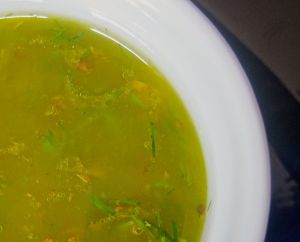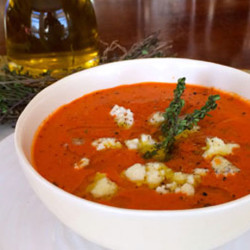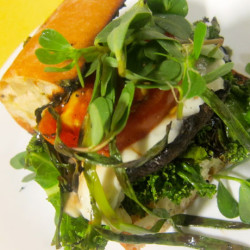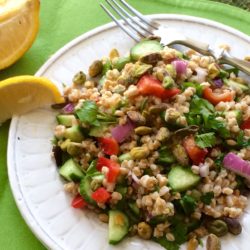Saturday, March 2, 2013
With its oregano and lemon-scented dressing and salad of greens, fresh dill, feta, and olives, Greek salad is a must-have part of your mealtime repertoire.
 Whether as a side or its own “big salad for dinner,” I really enjoy a good Greek salad full of big, heart-healthy, Mediterranean flavors.
Whether as a side or its own “big salad for dinner,” I really enjoy a good Greek salad full of big, heart-healthy, Mediterranean flavors.
What I don’t love, however, is the nutritionally limited versions you often find in restaurants and cafés. In other words, many Greek salads are basically iceberg lettuce with very few vegetables and lots of cheese. Iceberg lettuce has its merits, sure, but—how shall I put this?—it’s a “B” level vegetable due to its lower nutrient content compared to some of the more deeply hued greens like spinach, kale, or a mesclun mix. Crunchy, spring-green romaine lettuce is also a healthier choice.
Please don’t get me wrong: if you are a regular salad eater who loves iceberg lettuce, do keep on eating those salads. Better iceberg than no salad at all. Really. It’s just that you’ll get a lot more health benefits if you swap in a more nutrient-dense green. And if you add a few more veggies to the mix, even better.
Enter my version, what I’m calling a Modern Greek Salad. Like all of my salads, the produce included varies by mood and season. This variant stemmed from my discovery of purple-tinged mustard greens at my local market one autumn day. Sounds weird, I know, but it’s just a fun little green with incredible flavor. I added red radishes and purple scallions (green suffices, obviously, or red onions) alongside a few of the traditional components like dill, cucumber, feta cheese, and Kalamata olives for a wonderful side salad that I enjoyed with my roasted vegetable Greek sandwich with tzatziki one evening.
The Requisite Greek Dressing
Whatever veggies you select, the key to Greek salad is the dressing—and it can be part of a healthy diet, especially if you make it at home. (Here’s a video explaining why it’s so good for you.) This reminds me of another thing I don’t love about Greek salads, though, which is when it’s served, ironically, with non-Greek dressing. For example, I’ve had “Greek” salads arrive with Italian dressing or a basic balsamic vinaigrette. Uh… what? Seriously? There’s nothing wrong with a mixed salad with whatever dressing, but it’s not a Greek salad unless it includes Greek dressing. Full stop.
All the more reason to avert Greek-salad-gone-awry situations like these and make your own at home. Here’s how.
Greek Salad + Dressing
Ingredients and Instructions. Olive oil, lemon juice, white wine vinegar (or red), crushed garlic or finely minced shallot, dried oregano, salt, pepper. Oregano is the key to Greek salad dressing. Mix acids, aromatics,  and spices together. Say, juice from 1/2-1 entire lemon, 1-2 teaspoons of wine vinegar, 1-2 teaspoons garlic/shallots. and ~1-1.5 tsp oregano. Quantities depend on how much you’re making, so try and get the hang of making things to taste. Now, pour in olive oil while whisking until the dressing thickens. Season with a crush of black pepper and a pinch of salt, taste, and adjust the balance by adding more oil or lemon juice/vinegar as needed. For fun, sometimes I add a touch of dijon for additional body and flavor, or a bit of finely chopped fresh oregano if I have it (that’s the brighter green in the picture). Need more details? Check out this video where I make maple-dijon vinaigrette; it’s the same basic idea.
and spices together. Say, juice from 1/2-1 entire lemon, 1-2 teaspoons of wine vinegar, 1-2 teaspoons garlic/shallots. and ~1-1.5 tsp oregano. Quantities depend on how much you’re making, so try and get the hang of making things to taste. Now, pour in olive oil while whisking until the dressing thickens. Season with a crush of black pepper and a pinch of salt, taste, and adjust the balance by adding more oil or lemon juice/vinegar as needed. For fun, sometimes I add a touch of dijon for additional body and flavor, or a bit of finely chopped fresh oregano if I have it (that’s the brighter green in the picture). Need more details? Check out this video where I make maple-dijon vinaigrette; it’s the same basic idea.
Salad assembly. Mix together gently your lettuces and other veggies with roughly chopped fresh dill, which is the other key to Greek salad. Note that there are pros and cons of adding the cheese at this point, as it can over-crumble and coat everything. Toss with dressing here for one big bowl—don’t drown it!—or pass around separately after plating individual salads. Top the lettuce mixture artfully with the cheese, olives, and a few additional scallions for garnish.
I just adored the texture and visual beauty of the mustard greens, and it was a pleasant surprise just how well they worked in this salad: truly the perfect foil for the lemony, herbaceous notes of the dressing. Even so, use the greens make you happy—always better to eat salad than not—but whatever you choose, it’s the zingy dressing and fresh dill that will sing “Greek salad.”
Here’s to sensational, heart-healthy food!





I love, love, love a good greek salad, but haven’t found a dressing to make at home that is quite right. I like the looks of this one though! Thanks!
Acid to oil ratio is generally 1:2 but it varies by taste and oregano depends on how much you are making – start with less as you can’t go back – but this is a classic recipe that I love. I hope you enjoy it as much as I do. Let me know! Cheers, PKN